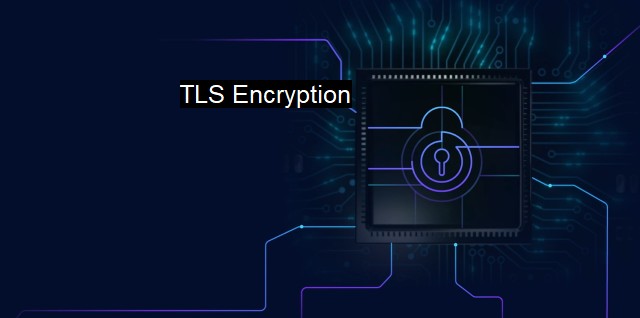What is TLS Encryption?
The Growing Importance of Transport Layer Security (TLS) Encryption in Protecting Against Cybersecurity Threats
Transport Layer Security (TLS) encryption is an advanced data security protocol used universally on the internet for protecting information during its transmission. it plays a tremendous role in enhancing information privacy and securing online communications.TLS sits in between the application layer and the transport layer of internet browsers and ensures secure transmission back and forth between servers and users. Common applications using TLS include web browsing, emails, Instant Messaging (IM), and Voice over IP (VoIP).
The key functionality of TLS encryption involves building a secure channel for the mutual communication of client and server computer systems, guarding their discussion against potential security breaches. TLS encryption legitimizes a server's identity through various cryptographic techniques which collectively ensure confidentiality, authenticity, and data integrity.
Confidentiality ensures that only the sender and the intended recipient can access and understand the information being communicated. It is achieved using symmetric encryption wherein both parties share a key which decrypts the disguised, transmitted message on reaching its destined device.
Data integrity refers to the protection of data from getting altered or corrupted throughout its transmission. If a cybercriminal tries to modulate the data during its travel over the network, the recipient system will detect the tampering attempt. This is possible because of a technique called hashing coupled with a message authentication code.
The authenticity aspect of TLS ascertains the legitimacy of the server to which users connect. It uses public-key infrastructure (PKI) and a digital certificate authorized by a trusted third party, called Certificate Authority (CA), assuring the client system that they're connecting with the correct server.
When a client first connects to a TLS-protected server, they initiate a process called the TLS handshake. During this procedure, the server presents its digital certificate to validate its identity. Simultaneously, the client and server agree upon the specifics of the symmetric encryption - the encryption mechanism and the shared secret key. Once the handshake is successful, the secure connection is established.
Ever since its derivation from SSL (Secure Socket Layer) designed by Netscape, TLS encryption has been providing online security solutions according to the dynamism of cybersecurity. Updated versions of this protocol deliver more coordinated work against critical security situations by providing cryptographic agility.
It is vital to comprehend that TLS cannot combat every security peril. If a system is compromised by malware or a user unwittingly provides information to fraudulent agents, TLS cannot directly intervene. Given this, it should ideally be one part of a broader cybersecurity arsenal - to service other more locally concentrated defense mechanisms like antivirus software.
For enhanced security, many organizations pair TLS encryption with the robust protection of antivirus software. While the TLS protocol safeguards data and communication over the internet, antivirus software secures computers systems by identifying, preventing, and eliminating different types of malicious software which could create potential breaches via multiple non-secure channels.
As our world becomes vastly interconnected, cybersecurity threats evolve in complexity and number. Defending sensitive information becomes a top priority. In this context, TLS encryption remains a powerful tool, providing a critical first line of defense for online communication. It is not a standalone solution and needs to be used as part of a wider, more comprehensive approach to overall cybersecurity involving other mechanisms, like a reliable antivirus. This approach ensures robust security from both online and offline threats. antivirus is a complement to TLS, barring any malware is present on a server or a user's device. Hence, the two in harmony provide relatively complete web security. TLS encryption has a crucial part to play in making the online world a safer place.

TLS Encryption FAQs
What is TLS encryption?
TLS encryption stands for Transport Layer Security encryption. It is a secure protocol that provides privacy and data integrity for internet communications. It is widely used in cybersecurity to protect online data transfer and communication.How does TLS encryption work?
TLS encryption starts with a handshake process between the client and server, where they establish a secure connection and exchange cryptographic keys. Once the connection is established, all data transmitted between the client and server is encrypted using these keys, making it more secure against unauthorized access.Why is TLS encryption important in antivirus software?
TLS encryption is crucial in antivirus software as it helps secure the communication between the user's device and the antivirus company's servers. It ensures that the data transmitted during the antivirus updates and virus scans is protected against cyber-attacks. This helps prevent malware from intercepting, modifying or stealing the data exchanged between the user and the antivirus servers.Are all websites encrypted with TLS?
No, not all websites are encrypted with TLS. Some websites still use the less secure HTTP protocol instead of HTTPS, which uses TLS encryption. This makes them vulnerable to cyber-attacks, such as man-in-the-middle attacks or data interception. It is important to verify that websites are encrypted with TLS before sharing sensitive information or making online transactions.| | A | | | B | | | C | | | D | | | E | | | F | | | G | | | H | | | I | | | J | | | K | | | L | | | M | |
| | N | | | O | | | P | | | Q | | | R | | | S | | | T | | | U | | | V | | | W | | | X | | | Y | | | Z | |
| | 1 | | | 2 | | | 3 | | | 4 | | | 7 | | | 8 | | |||||||